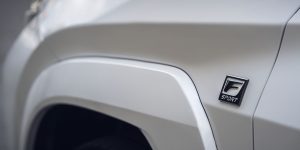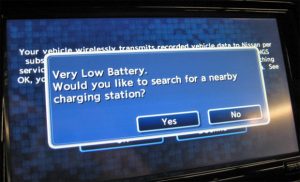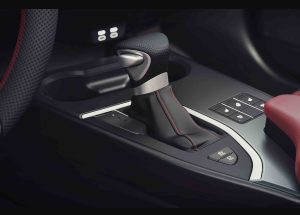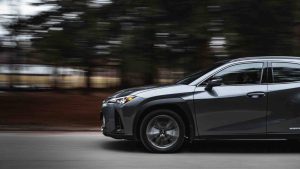There are lots of compact-sized, luxury-brand crossovers.
And there are lots of hybrid crossovers, too.
But there’s just one compact-sized, luxury-brand crossover that’s a hybrid, too.
The Lexus UX250h.
What It Is
Per the above, the UX250h is a small hybrid crossover made by Lexus. It is the only model of its type in the segment and it averages better than 40-miles-per-gallon, which is about 10 miles-per-gallon better than other small, luxury-brand crossovers that aren’t hybrids like the BMW X1 and Mercedes GLB, for instance can manage on the highway. It is also priced lower to start – $35,400 for the front-wheel-drive version and $37,250 with AWD – than the non-hybrid small crossovers mentioned above, which start at $38,600 and $39,800 respectively.
Even the top-of-the-line F-Sport Handling version of this small Lexus – which includes a sport tuned suspension, bolstered sport seats, gauge similar in look/layout to the LF-A supercar’s and most of the equipment that’s optional in the lower trims – stickers for just $42,700.
That’s about $8k less than the loaded versions of other small, luxury-branded crossovers like the X1 and GLB.
This is remarkable because it is usually the case that a hybrid costs more to buy than an otherwise similar non-hybrid, which takes away from the savings you might realize by driving it.
Of course, there’s a cost for everything – and when it comes to the UX relative to models like the X1 and GLB and others in the class, it comes in the form of being a little slower to get going and a bit less leg room on back and cargo room (the latter item due to the UX’s drivetrain layout and lower-than-others roofline).
The major change is a deletion – of the non-hybrid version of the UX (the UX200). It probably won’t be missed, though – because it only cost slightly less ($33,450 to start) and cost a lot more to drive (32 MPG, average).
The hybrid UX250h gets am updated 12.3 inch optional LCD touchscreen and new F Sport iterations (Design and Handling).
What’s Good
The only small luxury-brand hybrid that costs less to drive than most economy-priced cars.
Costs less to buy than more expensive-to-drive small luxury-brand crossovers.
Doesn’t look like every other small crossover.
What’s Not So Good
With rear seats up/in use, cargo space available behind them is small.
Backseat legroom (just 33.1 inches) is significantly less than in several rivals.
Takes longer to get up to speed than non-hybrid rivals.
Every UX is powered by a combination 2.0 liter gas engine/electric motors (AWD models have two, one driving the rear wheels) and a nickel-metal hydride (NiMH) battery pack to store electricity generated by the engine. It powers the motor(s) that provide supplementary power when the gas engine isn’t needed – which allows for it to be automatically turned off during light-load cruising, deceleration and when the UX isn’t moving.
That’s how the UX achieves 43 MPG in city driving and 41 on the highway.
There are a few non-hybrid economy cars capable of going 40 miles-per-gallon on the highway, or even a little farther. But none of them approach 40 miles-per-gallon in the city, which is where a hybrid like the UX does best – while also doing much better on the highway – especially if it’s cold or hot outside – than any electric car.
With a full tank (10.6 gallons) the UX can go 434 highway miles before it needs more gas. That is farther than any EV can go – and that’s with the AC or the heat on, as you like and as much a you like as using either doesn’t appreciably affect this car’s range, as it would an electric car’s.
You’ll get going, again, a lot sooner because it only takes a few minutes to add 10.6 gallons to the UX’s tank. As opposed to having to wait at least 30-45 minutes to put a partial charge in an EV. Assuming you can find a “fast” charger.
If you can’t, you’ll be waiting for hours.
This is the huge upside to hybrids, which can be thought of as EVs that work. They have batteries and motors, like an EV. But they lack the tether – to a power source – that besets every EV. They are also a better long-term bet, in terms of the lesser likelihood that you will be faced with having to spend more on a new battery pack than is worth spending on the car. Replacement EV battery packs cost twice as much (or more) than the typical replacement cost for a modern car’s automatic transmission, which is typically in the neighborhood of $4,000 or so.
And because EVs rely solely on their batteries for power, EV batteries are worked harder. They are “on” – and being drained – all the time and often are drained completely, or nearly so – and then subjected to high-voltage “fast” charging, which is known to reduce the service life of any battery. Your choice is convenience (the “fast” charge) at the cost of degrading the very expensive battery. Or regular and long waits – for a slow charge. Which costs you time and hassle.
A hybrid’s battery is never heavily discharged because the gas engine is always there to make sure it isn’t. 
The system assures the gas engine kicks on – as a generator – to provide electricity to the battery before it is heavily discharged. And it is not subject to the stress of “fast” charging. That – and the fact that a hybrid’s battery is only partially responsible for moving the car – means an easier life and a battery that will probably last as long as the car does. Or at least, for a very long time. The odds are you’ll be able to drive a hybrid UX every day for at least 12 years before the battery begins to show signs of aging. The similar-in-layout Prius hybrid has a track record for doing just that and because of that is very popular as a taxi – which ought to tell you something about this hybrid’s probable longevity.
But there is another thing the UX has in common with the Prius. This Lexus needs about 9 seconds to get to 60. It’s not quite as slow as a Prius – but it’s nowhere near as quick as other small, non-hybrid crossovers like the BMW X1 I reviewed last week (see here, if interested) or others in the class, most of which get can get to 60 in less than six seconds.
The old saying about speed being a question of money – how fast do you want to go? – can be restated in fuel-efficiency terms. Mileage being a question of how slow you’re willing to go.
Once you get going, the UX is pleasant – even fun – to drive. The operative being the italicized.
The good news is you will only notice this when you need to get going, as in quickly.
The UX isn’t slow, in relative terms.
It is actually quicker than some of the V8 sleds of the ’70s, believe it or not (as Jack Palance used to say). And it feels quicker than it is, so long as you don’t need it to be actually quick. Part-throttle acceleration is up to par with the ebb and flow of traffic and the torque provided by the electric motor(s) is EV-like and also similarly silent. This Lexus has no trouble at all comfortably holding 75-80 MPH, which is about as fast as highway traffic is generally flowing.
But if you need to merge with traffic going that fast . . . then you will notice how quick the UX isn’t.
The upside is this is mostly a problem of non-anticipation. Every person reading this who has driven a slow car knows exactly what that means.
Said another way, slowness is only a problem – mostly – if you don’t anticipate the need to build a head of steam and maintain it, as necessary. You will only have problems if you creep up a merge ramp doing 35 and expect to merge with traffic doing 75-80. You won’t if you use every bit of that ramp to build up speed enough so that you’re not doing 30 MPH less than the traffic you’re trying to merge with when you try to. Similarly, you can maintain momentum in between traffic lights, so that you’re still moving while others have slowed (or stopped) which makes you faster than they are. Even if they are – by the numbers – quicker.
And – once you’re moving – this little hybrid has verve, as in the curves. You can enter them at speed – and so long as you don’t bleed too much speed in the curves – you will find you can leave behind many a by-the-numbers faster crossover.
Lexus enhances the feeling that you’re driving something that isn’t chiefly about economy via the angular, stealth-fighter shape of the thing on the outside and the similar vibe-feel on the inside, which is centered (for the driver) on the configurable, LF-A supercar-inspired gauge cluster and the fighter-interceptor look and feel of the knobs and controls. It is like driving the un-Prius, while still enjoying about 80 percent of the gas mileage you’d get in a Prius.
And easily 20-30 percent better than you’d get out of a BMW X1, Benz GLB or Audi Q3.
The UX is about the same overall length (177 inches) as a BMW X1 (177.2 inches) or an Audi Q3 (176.6 inches) but it is lower and more aggressive-than-utilitarian looking. It has planes and sharp angles; its roofline seems low relative to the body, which gives it a snarky squat. Lexus did a lot in terms of styling to make this small crossover not look like every other crossover.
But there is a cost – which comes mainly in the form of a smaller-than-most cargo area – which doesn’t hold as much as the cargo areas of other small crossovers such as the Benz GLB – which has 25.7 cubic feet behind its third row vs. just 17.1 cubic feet for the UX. Part of the reason for the smallness has to do with the lowness of the UX’s tapering roofline. Also, the floor of the UX’s cargo area is higher, in order to make room underneath for some of the hybrid drivetrain’s components.
The upside is you can make more space – for cargo – by not using the rear seats. As in all crossovers, they fold forward and that opens up two-thirds of the interior to cargo. You can carry home long items in the UX that would never fit inside a car twice this size.
On the downside, you can only make more space for cargo by not using the rear seats – which can present a Catch 22 if you need to carry passengers and cargo at the same time.
The other downside is not really crutchable.
The UX has much less rearseat legroom (33.1 inches) than other small luxury-brand crossovers like the X1 (which has 37 inches of backseat legroom) and the Benz GLB (which has 38.1 inches). It is a tight squeeze for adults back there, though teenagers and younger will fit and are able to get back there easily enough.
The Rest
Though the UX does have a big touchscreen, you don’t have to touch it – to adjust the volume of the stereo, at least. You do, however, if you want to change the channel. It’s either that or use the trackpad input on the center console. Or, your voice. Just say Hey, Lexus – and the personal assistant and . . . help.
Clever – and helpful – design touches include a center console storage top that flips open both ways – for the driver and the passenger. There is also still a 12v power point socket, a necessary feature if you still use accessories with 12V pigtail power points.
The Bottom Line
It costs less to drive – and it costs less than may others that cost more to drive. That sounds like a pretty good deal, if you’re looking to save money – by not spending it.
. . .
If you like what you’ve found here please consider supporting EPautos.
We depend on you to keep the wheels turning!
Our donate button is here.
If you prefer not to use PayPal, our mailing address is:
EPautos
721 Hummingbird Lane SE
Copper Hill, VA 24079
PS: Get an EPautos magnet or sticker or coaster in return for a $20 or more one-time donation or a $10 or more monthly recurring donation. (Please be sure to tell us you want a magnet or sticker or coaster – and also, provide an address, so we know where to mail the thing!)
My eBook about car buying (new and used) is also available for your favorite price – free! Click here. If that fails, email me at EPeters952@yahoo.com and I will send you a copy directly!

















It’s got a tablet protruding from the dash like every other car built today. I wouldn’t give 10 cents for that thing.
ZH – “Cars all looks the same
In 2015, the ex-Chairman of BBH London, Jim Carroll recalled his realisation 32 years earlier that aerodynamic tests had begun to make all cars look alike:
“Some of you will recall the day in 1983 when we woke up and noticed that the cars all looked the same. There was a simple explanation. They’d all been through the same wind tunnel. We nodded assent at the evident improvement in fuel efficiency, but we could not escape a weary sigh of disappointment. Modern life is rubbish.”
In Carroll’s opinion, because all vehicles underwent the same wind tunnel tests, manufacturers were independently converging on the same optimal set of forms, proportions and dimensions. And as a result, homogeneity in car design was increasing.
What Carroll didn’t realise was that things were about to get a lot worse.
Sat at a red light, Drew Magary took the opportunity to scope out some new car ideas. Suddenly he saw an SUV that looked attractive. But he couldn’t quite see the badge. Another car was blocking his line of sight:
“Maybe it’s a Bimmer,” I said to the dog. “It kinda looks like one.” It wasn’t. It was a Hyundai Santa Fe, which kinda resembles the Acura RDX, which kinda resembles the Volvo XC60, which kinda resembles the BMW X3. (…) These four models are all 75 inches wide, 66 inches high (save for the Volvo, which is 65), and they only differ in length by a maximum of three inches. They all have rear quarter windows smaller than a porthole on a submarine. They all have chrome accents to increase the glam factor by, like, five percent. And they all abhor right angles, (…). They’re spiritual clones, and they’re not exceptions in being so.””
https://cms.zerohedge.com/s3/files/inline-images/The%2BAge%2Bof%2BAverage_0008_Cars%2B-%2BForm.jpg?itok=KveG8S8o
I noticed it comes with a nickel-metal hydride (NiMH) battery pack. So does this mean that it is less likely to spontaneously combust compared to the lithium ion battery pack? Only time will tell but if it’s less likely to catch fire that would definitely be a selling feature.
at least it’s not an EV – yet
Indeed, Dan –
As opposed to what’s coming today…
Yawn….it does look like every car on the road. They all look the same. We are only offered smaller, more complicated, more expensive packages, just like food companies. Smaller product, more expensive. You can have passengers or cargo, but not both. There is no legroom at all.
There is no reason in the world for vehicles to be as expensive as they are in this day and age except for the fact, TPTB want it this way. There is no ‘oil/energy’ shortage except again TPTB want it to be. This has all been discussed many times here.
John K., it’s not a station wagon in the same sense as the old station wagons were, not even close. If it was a full-on EV, you probably could eventually call it a ‘stationary’ wagon.
“but it is lower”
In other words, it’s a station wagon.